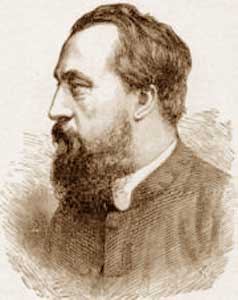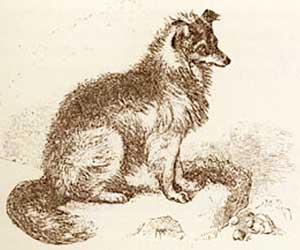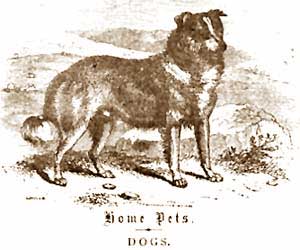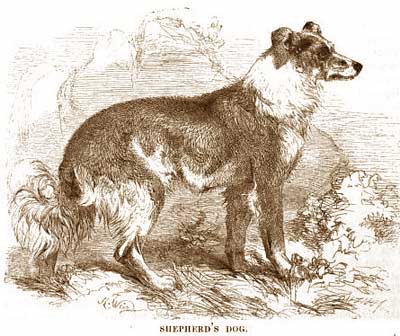

![]()
JOHN GEORGE WOOD
1827-1899

Above, a photo of J. G. Wood
(From The Project Gutenberg eBook,
Great Britain and Her Queen, by Anne E. Keeling)
 Left, a shepherd's dog, from one of J. G. Wood's natural history books, artist unknown.
Left, a shepherd's dog, from one of J. G. Wood's natural history books, artist unknown.
John George Wood was a popular British writer on natural history. Born in London, Wood was the son of a surgeon. His early education was at home, and he earned a B.A. in 1848 and his M.A. in 1851 from Merton College, Oxford. He also studied at Christ Church, Oxford, where he worked for some time in the anatomical museum under Sir Henry Acland, a noted English physician. In 1852 Wood became a curate and in 1854 was ordained a priest.
Wood began to give occasional lectures from 1856, but in 1876 he began to devote himself to the production of books and to delivering lectures on zoology, which he illustrated by drawing on a black-board or on large sheets of white paper with coloured crayons. These "sketch lectures," as he called them, were very popular, and he became widely known for them both in Great Britain and the United States, and they constituted a second profession for him.
J.G.Wood was a very prolific writer on natural history, though rather as a populariser than as a scientific investigator, and was in this way very successful. The books that would interest us most as sheepdog enthusiasts are his natural history books on animals, for in them he included the shepherd's dog. In his Natural History Picture Book for Children: Mamalia (1861, Routledge, Warne, & Routledge), Wood's first book of this type, he says:
Right, "Shepherd's Dog" from the Illustrated Natural History for Young People by J. G. Wood, artist unknown.
What would a shepherd do without his dog? Twenty men could not look after a flock of sheep as well as a single dog. He keeps always on the watch, takes care that the animals go the right way; and as soon as he sees a sheep straying even two of three yards from the flock, he rushes up and drives it back to its proper place. And the sheep soon find out that the dog is not their tyrant, but their friend, and will sometimes trust and obey him, even when they will not listen to the shepherd.The Collie, or Scotch dog, is in his line of life one of the most perfect animals in the world. His thick furry coat protects him in the snowy Highlands; and when he lays himself down to sleep, his bushy tail covers his paws and nose and keeps them warm. His large head gives room for the brain which is so much needed for his work, and his powers of scent are very great.
As they always live with their masters, the sheep-dogs learn not only to understand certain words and signs of command, but learn to know wha people are talking about. For example, a sheep-dog, on hearing that some cows had broken into a field, went at once to the spot for the purpose of turning them out. Another heard his master mention that he was going to a certain town to attend a market, and would leave his dog at home. He went by train, attended the market, and before the day was over his dog met him in the market-place.
It's unclear if Wood heard these stories first hand, or he used secondary sources, but I suspect the latter. His writing seems deriviative. In his Illustrated Natural History for Young People (1882, George Routledge & Sons, London) Wood describes the shepherd's dog briefly in his chaper on dogs (which, by the way, seems to include the Prairie Dog!).
The shepherd's Dog is a rough, shaggy animal, with sharp-pointed ears and nose. It is an invaluable assistant, never suffering the sheep to stray, and when two flocks have mixed it will separate its own charge with the greatest certainty. It understands every look and gesture of its master, and drives the flock to any place which he points out.
This harks back to Caius and Buffon, as the previous quote harked back to Hogg and others. Again is his Natural History Picture Book for Children Wood says of the shepherd's dog:
The most useful variety of the canine species is that sagacious creature on whose talent and energy depends the chief safety of the flock.
This animal seems to be, as far as can be judged from appearances, the original ancestor of the true British Dogs, and preserves its peculiar aspect in almost every country in Europe.
This comes straight out of Buffon and rather proves that Wood likely had not seen shepherds' dogs first hand, at least not anywhere but Britain. He goes on to say,
It is a rather large Dog, as is necessary in order to enable the animal to undego the incessant labour which it is called on to perform, and is possessed of limbs sufficiently lare and powerful to enable it to outrun the truant members of the flock, who, if bred on the mountain-side, are so swift and agile that they would readily baffle the efforts of any Dog less admirably fitted by nature for the task of keeping them together.
As the sheep-dog is constantly exposed to the weather, it needs the protection of very thick and closely-set fur, which , in this Dog, is rather woolly in its character, and is especially heavy about the neck and breast. The tail of the Sheep-dog is naturally long and bushy, but is generally removed in early youth, on account of the now obsolete laws, which refused to acknowledge any Dog as a Sheep-dog, or to exempt it from the payment of a tax, unless it were deprived of its tail. This law, however, often defeated its own object, for many persons who liked the sport of coursing, and cared little for appearances, used to cut off the tails of their greyhounds, and evade the tax by describing them as Sheep-dogs.
. . .
Probably on account of its constant exercise in the open air, and the hardy manner in which it is brought up, the Sheep-dog is perhaps the most untiring of our domesticated animals.
Wood makes a mistake that many people have made. He takes the collie's diversity of looks to mean that differnt dogs were crossed with other breeds to make the type of dog he saw:
There are many breeds of this animal, differing from each other in colour and aspect, and deriving their varied forms from the Dog with which the family has been crossed.
 Right, an illustration from The Boy's Modern Playmate: A Book of Sports, Games, and Pastimes by the Rev. J.G. Wood (Frederick Warne and Co., 1891)
Right, an illustration from The Boy's Modern Playmate: A Book of Sports, Games, and Pastimes by the Rev. J.G. Wood (Frederick Warne and Co., 1891)
Because Wood was a prolific writer of natural history, many of his books written with children in mind, he contributed to the dissemination of information on the shepherd's dog to the general public; but also unknowingly spread much misinformation because of his probable lack of first hand observation or by relying on earlier writers. In his Boy's Modern Playmate, basically a book on sports and games, Wood cannot help inserting his interest in natural history with a chapter on "Home Pets - Dogs". Of the shepherd's dog he says:
The Sheep Dog has undoubtedly a higher commercial value than any other [breed of dog], as he has often under his charge a flock worth thousands of pounds. There are various breeds in use throughout the United Kingdom, some smooth, but the majority more or less rough. The most distinct of these is the Scotch collie.
The English Rough Dog has nearly always a wiry muzzle, and a good useful hard coat of hair over his whole body. The best specimens are not so long in the leg as the generality of dogs, and when they have tails they carry them lower than the Scotch dog...In those districts where large numbers of sheep are kept, great attention is paid to their education, and a good sheep dog is considered as indispensable to the well-doing of a flock as a good shepherd. For the last ten years a class has been made in our large shows for the bob-tailed rough sheep dog. He is a strong and yet symmetrical dog, with a wiry muzzle and a head wholly unlike that of the foxy collie. Generally his colour is a dull brindle, mixed with white on the neck and legs, but he is sometimes black and white, and at others red and white.
We assume he is speaking here of the Old English Sheepdog. It would be exciting indeed to be able to say that this breed or type once came in colors other than only the grey and white we see today, but we can't rely on Wood's accuracy. In this book his interpretation of the collie is as "two races...to be found in Scotland--the rough and the smooth." For these, the colors he gives for the rough are "a deep, warm, long coat of various colours--sometimes black with light tan points," (black-and-tan); "sometimes sandy," (sable or recessive yellow); "or of various mixed greys," (blue or blue-merle) "some of which are singularly beautiful and picturesque." He describes the rough collie as if by a show standard, and indeed he may have used the Kennel Club standard for his account, since he mentions shows in connection with the OES, above. For the smooth coated collie, which he obviously thinks of as a separate breed, the colors he gives are "blue and black mottled," blue-merle; "or of a sandy colour, although occasionally he may be met with of the black and tan or mixed tints." He mentions that "in some districts of Scotland and the north of England a smooth collie is still more highly prized."
 Left, "Shepherd's Dog" by Harrison Weir from The Illustrated Natural History: Mamalia by J.G. Wood.
Left, "Shepherd's Dog" by Harrison Weir from The Illustrated Natural History: Mamalia by J.G. Wood.
In The Illustrated Natural History: Mamalia (1865, George Routledge & Sons, London), which is the most detailed and perhaps the most "scientific" of Wood's natural history books, Wood devotes four pages to the "Sheep-dog", distinguishing among the "English Sheep-dog", the "Scotch Sheep-dog or Colley", the "Drover's Dog", and the "Cur Dog". Again, his writing seems derivative of Bewick, Hogg, Buffon, and others. The book is 800 pages, packed with species, types and breeds, some that are extinct today, and written at a time when many books like this were coming out with great regularity, and, there was a great demand for this type of book. People reading it were likely not to have read the earlier books by other authors, so in terms of reaching the general public, Wood was doing natural history, and by extension, the shepherd's dog, a service, despite inaccuracies. The book is beautifully illustrated by Harrison Weir and others. Illustrators rarely got credit in the 19th century, and the only way to know who they were is if they signed their work; Harrison Weir did, and so did others, but most signatures are unfortunately un-decipherable. There was no concept of copyright in the centuries before the 20th, so likely many of the illustrations that were used in books, were used without permission.
Copyright 2008 by Carole L. Presberg
THE OTHER WEB PAGES WE MAINTAIN
These web pages are copyright ©2013
and maintained by webmeistress Carole Presberg
with technical help from webwizard David Presberg
ALL RIGHTS RESERVED
If you are interested in using ANY material on this website, you MUST first ask for permission.